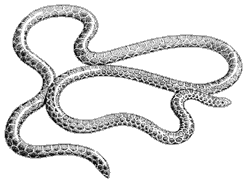Western Threadsnake
(Rena humilis)
Order: Squamata
Family: Leptotyphlopidae (blind snakes)
Other common names: worm snake
Spanish names: culebra
Distinguishing Features
This small snake, which is about as thick as a pencil lead on average, reaches a maximum length of 16 inches (40 cm). It is usually pale brown, pink, purplish, or beige with a silver sheen. The hard, shiny scales on the underside are similar in appearance to those on the back, except lighter in color. The head and tail are blunt, with a spine at the tail tip. Vestigial eyes appear as spots under the head scales. Teeth are lacking from the upper jaw.

Range
In the northern part of its range, the western blind snake occurs from southern California to western Texas. Continuing south into Mexico, it is found in all of Baja California and western and north-central Mexico.
Habitat
Found from below sea level to 5000 feet (1500 m), the western blind snake prefers moist, loose soils suitable for burrowing. This may include the sandy washes or canyon bottoms of mountain brushy areas or desert grasslands.
Life History
By spending most of its life underground, the western blind snake has no need for visual acuity. While not entirely blind, it does have vestigial eyes thought to be capable of seeing light only. If disturbed, it will writhe and wiggle its tail to focus attention here instead of on the head. Preyed upon by a wide variety of animals, including birds, mammals, snakes, fish and even spiders, the western blind snake is a specialist in its culinary desires: ants and termites along with their eggs, pupae, and larvae. Millipedes and centipedes are also occasionally eaten. When searching for food, a western blind snake will hunt until it finds an ant pheromone trail and follow it back to the nest to consume the residents. The smooth, tightly overlapping scales provide protection against the bites and stings of ants. This small serpent shares a feature with the much larger boas and pythons — the remains of a pelvic girdle and femur, complete with a tiny spur! A secretive, nocturnal snake, the blind snake lays up to 7 eggs in mid summer.